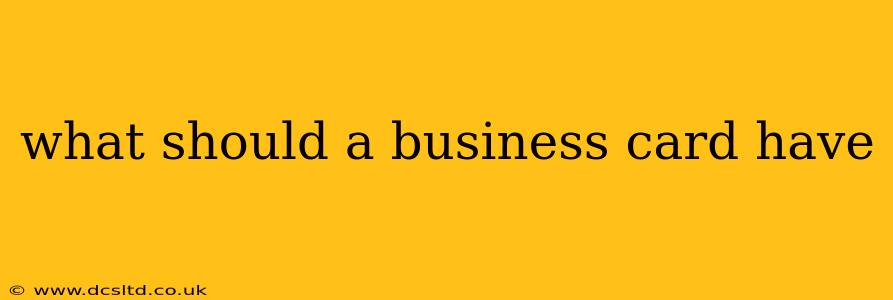What Should a Business Card Have? A Comprehensive Guide
A business card is more than just a piece of paper; it's a miniature representation of your brand and a powerful networking tool. A well-designed card leaves a lasting impression, fostering connections and driving business. But what elements are truly essential? Let's delve into the must-haves and helpful additions for a truly effective business card.
What is the most important information for a business card?
This boils down to the core information needed for someone to contact you. This includes:
-
Your Name: Clearly displayed and prominently featured, usually in a larger font size. Consider your preferred professional name; if different from your legal name, be consistent across all materials.
-
Your Title: This helps people understand your role and expertise within your company. Be concise and accurate.
-
Your Company Name: Equally important as your name; make it easily readable and recognizable.
-
Your Contact Information: This is crucial and often includes:
- Phone Number: Use a professional number, if applicable.
- Email Address: Professional email address, ideally reflecting your company name.
- Website: Your company website or a relevant personal portfolio link.
What else should I put on my business card?
While the essentials are important, strategically adding other details can enhance your card's impact. Consider these additions:
-
Your Address (Optional): Only include your address if it adds value; relevant for businesses with physical locations that clients might visit. For many professionals, a website or email suffices.
-
Social Media Handles (Optional): Include relevant social media links if they are actively used and professionally managed.
-
Logo (Optional): A small, high-quality logo adds professionalism and brand recognition. Avoid overcrowding the card with too many images.
-
QR Code (Optional): A QR code can link to your website, portfolio, or online calendar, adding an element of convenience.
-
Tagline/Slogan (Optional): A concise and memorable tagline can help define your brand and what you offer.
What size should a business card be?
The standard business card size is 3.5" x 2". Sticking to this standard ensures compatibility with most business card holders and printers. Deviating from this size can sometimes be acceptable for creative industries but generally isn't recommended for broader business use.
What is the best paper for business cards?
The paper stock you choose impacts the overall feel and impression of your card. Common options include:
-
Standard Card Stock: Cost-effective and readily available, but can feel less substantial.
-
Thick Card Stock: Provides a more luxurious feel and conveys professionalism.
-
Uncoated Card Stock: Provides a more natural feel and is easier to write on.
-
Coated Card Stock: Offers a glossy finish, protects the print, and provides a more polished look.
The best paper choice depends on your budget and brand image.
How can I make my business card stand out?
Beyond the content, consider the design and feel of your business card. Some ways to make it stand out include:
-
Unique Shape or Size: While less common, a slightly unconventional shape can draw attention. But keep it subtle.
-
Creative Design: Invest in professional design to create a visually appealing card that reflects your brand.
-
High-Quality Printing: Professional printing ensures crisp, clear text and vibrant colors.
-
Uncommon Texture/Finishing: Embossing, foil stamping, or other finishes add a touch of elegance and sophistication.
Ultimately, the best business card for you will depend on your specific needs and brand. Prioritize the essential contact information, then carefully consider the optional additions to create a card that is both functional and memorable.
